Question Number 175674 by infinityaction last updated on 05/Sep/22
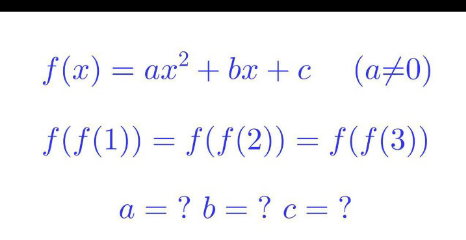
Answered by mr W last updated on 05/Sep/22
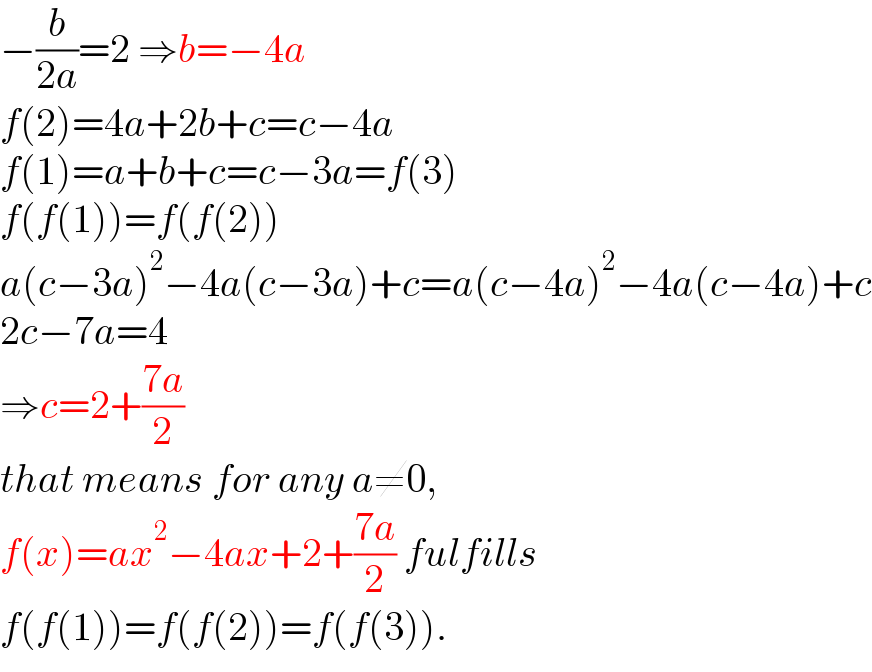
$$−\frac{{b}}{\mathrm{2}{a}}=\mathrm{2}\:\Rightarrow{b}=−\mathrm{4}{a} \\ $$$${f}\left(\mathrm{2}\right)=\mathrm{4}{a}+\mathrm{2}{b}+{c}={c}−\mathrm{4}{a} \\ $$$${f}\left(\mathrm{1}\right)={a}+{b}+{c}={c}−\mathrm{3}{a}={f}\left(\mathrm{3}\right) \\ $$$${f}\left({f}\left(\mathrm{1}\right)\right)={f}\left({f}\left(\mathrm{2}\right)\right) \\ $$$${a}\left({c}−\mathrm{3}{a}\right)^{\mathrm{2}} −\mathrm{4}{a}\left({c}−\mathrm{3}{a}\right)+{c}={a}\left({c}−\mathrm{4}{a}\right)^{\mathrm{2}} −\mathrm{4}{a}\left({c}−\mathrm{4}{a}\right)+{c} \\ $$$$\mathrm{2}{c}−\mathrm{7}{a}=\mathrm{4} \\ $$$$\Rightarrow{c}=\mathrm{2}+\frac{\mathrm{7}{a}}{\mathrm{2}} \\ $$$${that}\:{means}\:{for}\:{any}\:{a}\neq\mathrm{0},\: \\ $$$${f}\left({x}\right)={ax}^{\mathrm{2}} −\mathrm{4}{ax}+\mathrm{2}+\frac{\mathrm{7}{a}}{\mathrm{2}}\:{fulfills} \\ $$$${f}\left({f}\left(\mathrm{1}\right)\right)={f}\left({f}\left(\mathrm{2}\right)\right)={f}\left({f}\left(\mathrm{3}\right)\right). \\ $$
Commented by Rasheed.Sindhi last updated on 05/Sep/22

$${Sir}\:{I}\:{don}'{t}\:{get}:\:−\frac{{b}}{\mathrm{2}{a}}=\mathrm{2}\: \\ $$$${please}\:{explain}. \\ $$
Commented by mr W last updated on 05/Sep/22
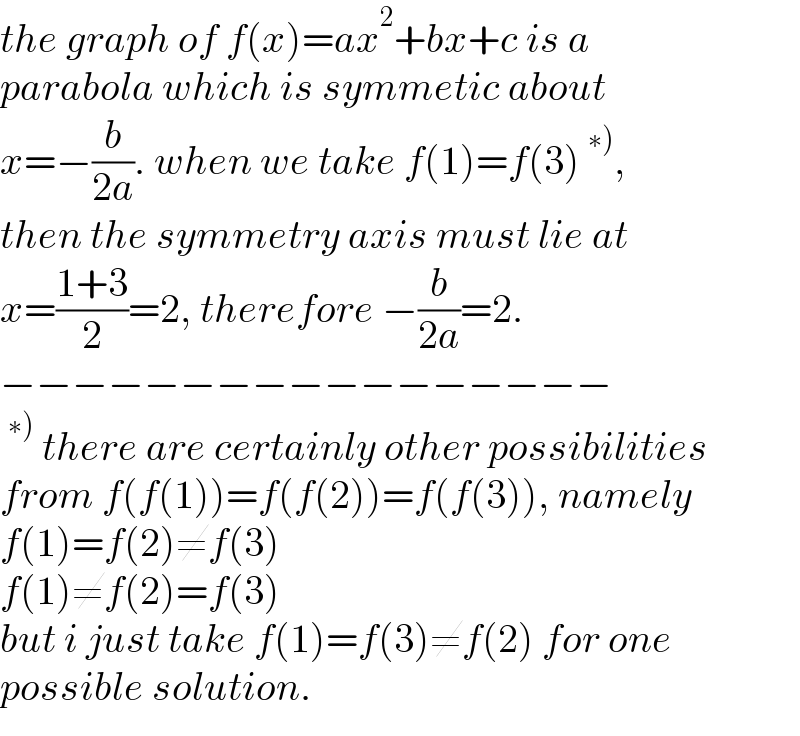
$${the}\:{graph}\:{of}\:{f}\left({x}\right)={ax}^{\mathrm{2}} +{bx}+{c}\:{is}\:{a} \\ $$$${parabola}\:{which}\:{is}\:{symmetic}\:{about} \\ $$$${x}=−\frac{{b}}{\mathrm{2}{a}}.\:{when}\:{we}\:{take}\:{f}\left(\mathrm{1}\right)={f}\left(\mathrm{3}\right)\:^{\left.\ast\right)} , \\ $$$${then}\:{the}\:{symmetry}\:{axis}\:{must}\:{lie}\:{at}\: \\ $$$${x}=\frac{\mathrm{1}+\mathrm{3}}{\mathrm{2}}=\mathrm{2},\:{therefore}\:−\frac{{b}}{\mathrm{2}{a}}=\mathrm{2}. \\ $$$$−−−−−−−−−−−−−−−−− \\ $$$$\:^{\left.\ast\right)} \:{there}\:{are}\:{certainly}\:{other}\:{possibilities} \\ $$$${from}\:{f}\left({f}\left(\mathrm{1}\right)\right)={f}\left({f}\left(\mathrm{2}\right)\right)={f}\left({f}\left(\mathrm{3}\right)\right),\:{namely} \\ $$$${f}\left(\mathrm{1}\right)={f}\left(\mathrm{2}\right)\neq{f}\left(\mathrm{3}\right) \\ $$$${f}\left(\mathrm{1}\right)\neq{f}\left(\mathrm{2}\right)={f}\left(\mathrm{3}\right) \\ $$$${but}\:{i}\:{just}\:{take}\:{f}\left(\mathrm{1}\right)={f}\left(\mathrm{3}\right)\neq{f}\left(\mathrm{2}\right)\:{for}\:{one} \\ $$$${possible}\:{solution}. \\ $$
Commented by mr W last updated on 05/Sep/22
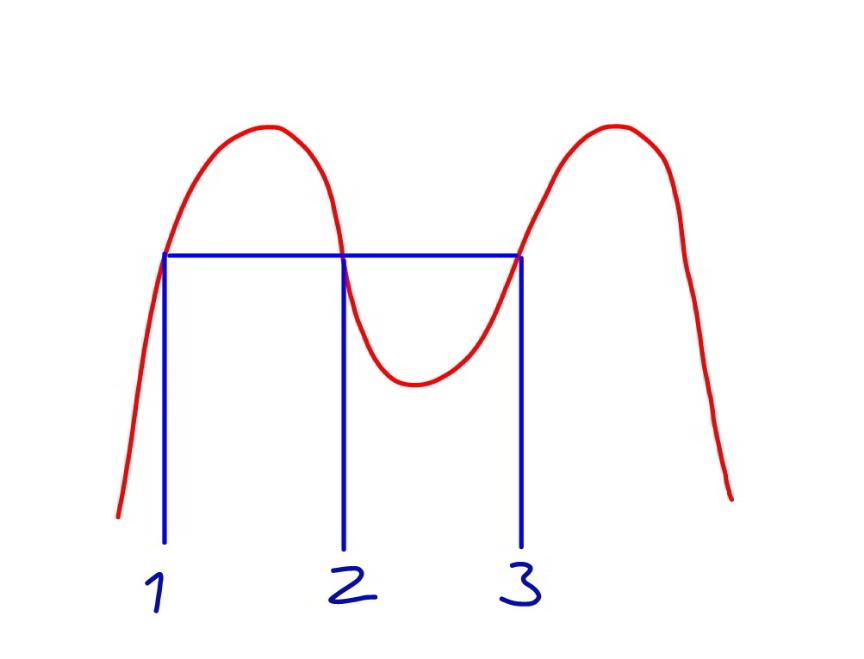
Commented by mr W last updated on 05/Sep/22
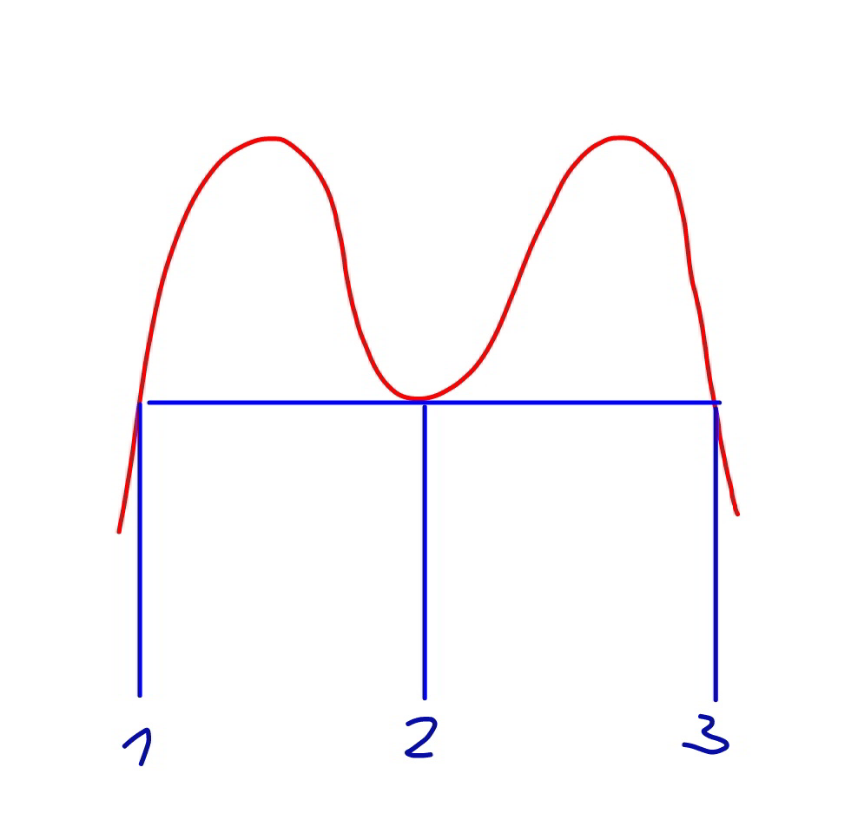
Commented by mr W last updated on 05/Sep/22
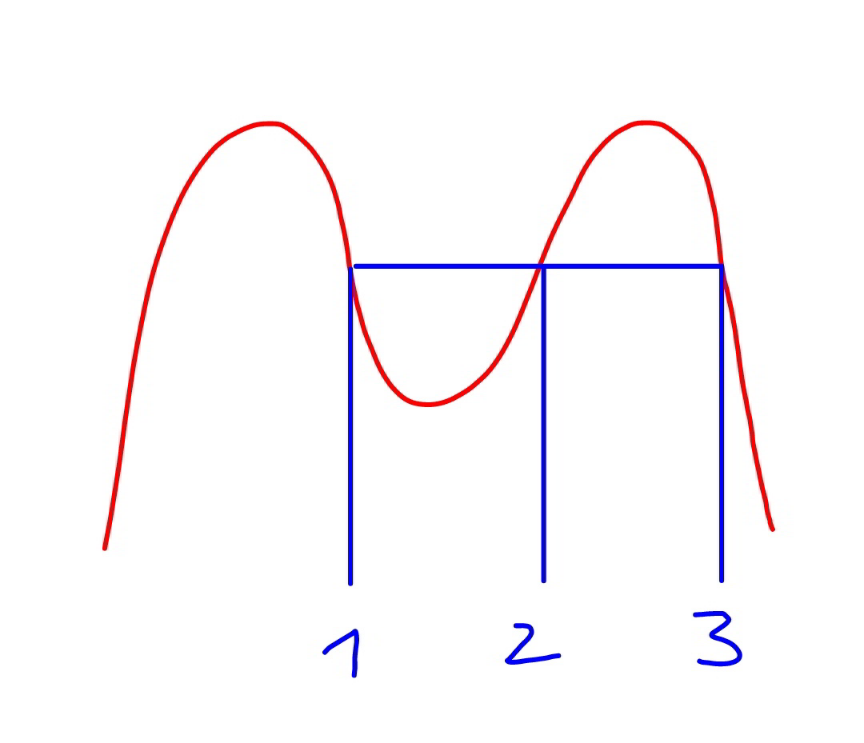
Commented by mr W last updated on 05/Sep/22

$${red}\:{curve}\:{is}\:{the}\:{graph}\:{of}\:{f}\left({f}\left({x}\right)\right). \\ $$$${the}\:{seccond}\:{case}\:{is}\:{that}\:{what}\:{i}\:{take}. \\ $$
Commented by mr W last updated on 05/Sep/22
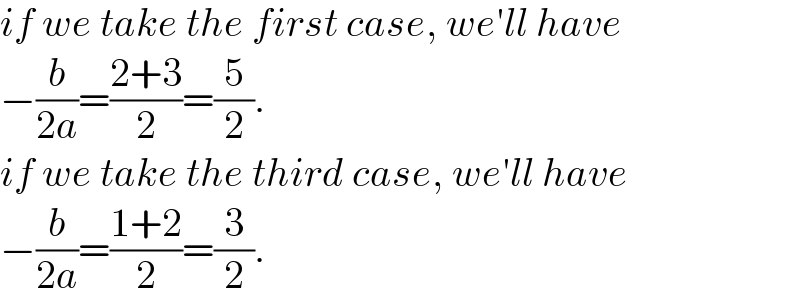
$${if}\:{we}\:{take}\:{the}\:{first}\:{case},\:{we}'{ll}\:{have} \\ $$$$−\frac{{b}}{\mathrm{2}{a}}=\frac{\mathrm{2}+\mathrm{3}}{\mathrm{2}}=\frac{\mathrm{5}}{\mathrm{2}}. \\ $$$${if}\:{we}\:{take}\:{the}\:{third}\:{case},\:{we}'{ll}\:{have} \\ $$$$−\frac{{b}}{\mathrm{2}{a}}=\frac{\mathrm{1}+\mathrm{2}}{\mathrm{2}}=\frac{\mathrm{3}}{\mathrm{2}}. \\ $$
Commented by Rasheed.Sindhi last updated on 05/Sep/22

$$\mathbb{T}\boldsymbol{\mathrm{han}}\Bbbk\boldsymbol{\mathrm{s}}\:\boldsymbol{\mathrm{a}}\:\boldsymbol{\mathrm{LOT}}\:\boldsymbol{\mathcal{S}}\mathcal{IR}! \\ $$
Commented by infinityaction last updated on 05/Sep/22

$${thanks}\:{sir} \\ $$
Commented by Tawa11 last updated on 05/Sep/22

$$\mathrm{Great}\:\mathrm{sirs}. \\ $$
Answered by mahdipoor last updated on 05/Sep/22
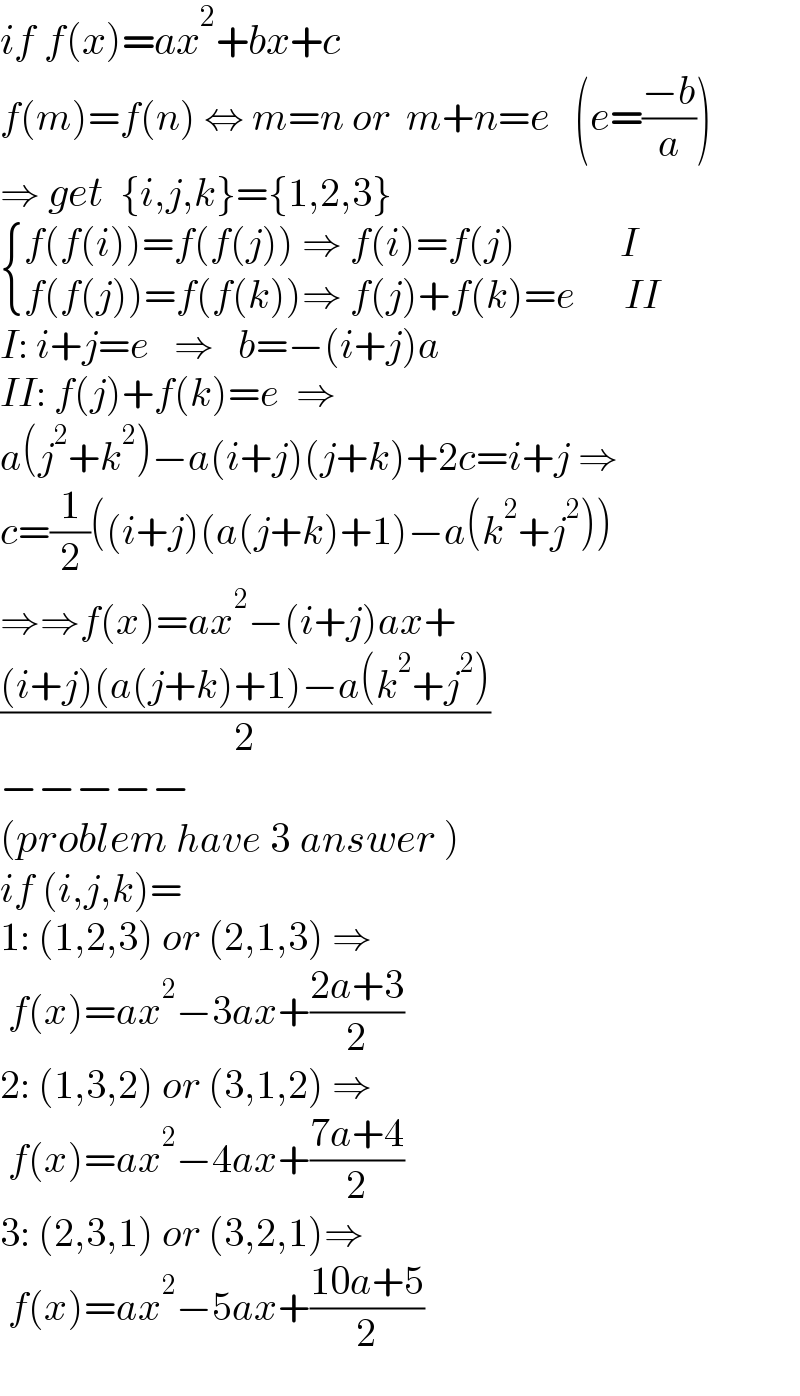
$${if}\:{f}\left({x}\right)={ax}^{\mathrm{2}} +{bx}+{c}\: \\ $$$${f}\left({m}\right)={f}\left({n}\right)\:\Leftrightarrow\:{m}={n}\:{or}\:\:{m}+{n}={e}\:\:\:\left({e}=\frac{−{b}}{{a}}\right) \\ $$$$\Rightarrow\:{get}\:\:\left\{{i},{j},{k}\right\}=\left\{\mathrm{1},\mathrm{2},\mathrm{3}\right\} \\ $$$$\begin{cases}{{f}\left({f}\left({i}\right)\right)={f}\left({f}\left({j}\right)\right)\:\Rightarrow\:{f}\left({i}\right)={f}\left({j}\right)\:\:\:\:\:\:\:\:\:\:\:\:\:{I}}\\{{f}\left({f}\left({j}\right)\right)={f}\left({f}\left({k}\right)\right)\Rightarrow\:{f}\left({j}\right)+{f}\left({k}\right)={e}\:\:\:\:\:\:{II}}\end{cases}\: \\ $$$${I}:\:{i}+{j}={e}\:\:\:\Rightarrow\:\:\:{b}=−\left({i}+{j}\right){a} \\ $$$${II}:\:{f}\left({j}\right)+{f}\left({k}\right)={e}\:\:\Rightarrow \\ $$$${a}\left({j}^{\mathrm{2}} +{k}^{\mathrm{2}} \right)−{a}\left({i}+{j}\right)\left({j}+{k}\right)+\mathrm{2}{c}={i}+{j}\:\Rightarrow \\ $$$${c}=\frac{\mathrm{1}}{\mathrm{2}}\left(\left({i}+{j}\right)\left({a}\left({j}+{k}\right)+\mathrm{1}\right)−{a}\left({k}^{\mathrm{2}} +{j}^{\mathrm{2}} \right)\right) \\ $$$$\Rightarrow\Rightarrow{f}\left({x}\right)={ax}^{\mathrm{2}} −\left({i}+{j}\right){ax}+ \\ $$$$\frac{\left({i}+{j}\right)\left({a}\left({j}+{k}\right)+\mathrm{1}\right)−{a}\left({k}^{\mathrm{2}} +{j}^{\mathrm{2}} \right)}{\mathrm{2}} \\ $$$$−−−−− \\ $$$$\left({problem}\:{have}\:\mathrm{3}\:{answer}\:\right) \\ $$$${if}\:\left({i},{j},{k}\right)=\: \\ $$$$\mathrm{1}:\:\left(\mathrm{1},\mathrm{2},\mathrm{3}\right)\:{or}\:\left(\mathrm{2},\mathrm{1},\mathrm{3}\right)\:\Rightarrow \\ $$$$\:{f}\left({x}\right)={ax}^{\mathrm{2}} −\mathrm{3}{ax}+\frac{\mathrm{2}{a}+\mathrm{3}}{\mathrm{2}} \\ $$$$\mathrm{2}:\:\left(\mathrm{1},\mathrm{3},\mathrm{2}\right)\:{or}\:\left(\mathrm{3},\mathrm{1},\mathrm{2}\right)\:\Rightarrow \\ $$$$\:{f}\left({x}\right)={ax}^{\mathrm{2}} −\mathrm{4}{ax}+\frac{\mathrm{7}{a}+\mathrm{4}}{\mathrm{2}} \\ $$$$\mathrm{3}:\:\left(\mathrm{2},\mathrm{3},\mathrm{1}\right)\:{or}\:\left(\mathrm{3},\mathrm{2},\mathrm{1}\right)\Rightarrow\: \\ $$$$\:{f}\left({x}\right)={ax}^{\mathrm{2}} −\mathrm{5}{ax}+\frac{\mathrm{10}{a}+\mathrm{5}}{\mathrm{2}} \\ $$
Commented by mr W last updated on 05/Sep/22

$${great}\:{solution}\:{sir}! \\ $$
Commented by mahdipoor last updated on 05/Sep/22

$$\heartsuit \\ $$
